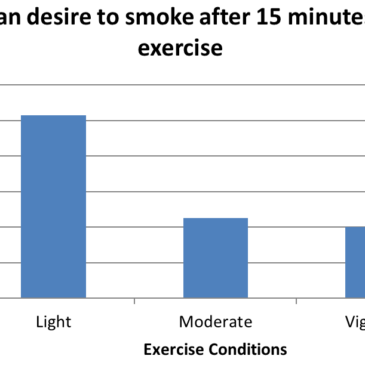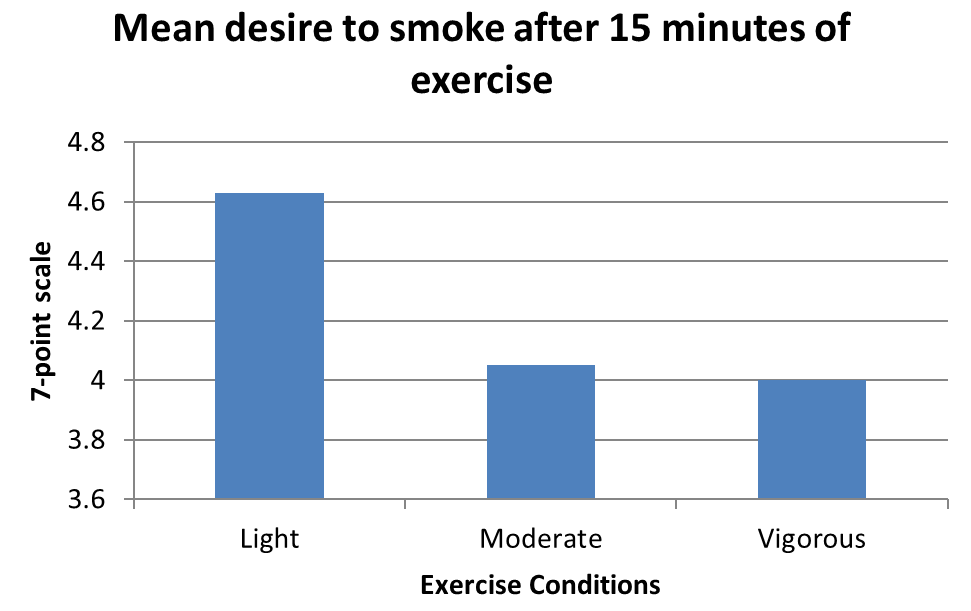Vigorous exercise reduces cigarette cravings in the short term (Haasova et al., 2013), but researchers are unsure why this occurs. By learning more about the underlying physiological and neurobiological factors involved, researchers might help people use exercise to quit smoking. This week, as part of our Special Series on Addiction and Sports, ASHES reviews a study that investigated potential underlying mechanisms involved in the relationship between exercise and reduction of cigarette cravings (Roberts, Gant, Sollers, Bullen, Jiang, & Maddison, 2015).
Methods
- The authors recruited 40 participants (25 male, 15 female, 18-59 years old), all smokers, from throughout Auckland, New Zealand.
- On three separate days, participants exercised for 15 minutes on a stationary bike. Each time, they exercised at light, moderate, or vigorous intensity. Participants were asked to refrain from smoking, eating, and drinking (except water) for 12 hours before each assessment.
- Measures included:
- Cigarette cravings, measured on a 7-point scale (1 – “strongly disagree” to 7 – “strongly agree”) in response to the statement “I have a desire to smoke right now.”
- Blood samples (for cortisol and noradrenaline) and saliva samples (for cortisol) were taken 30 minutes before exercise and 5, 10, 20, 30, and 60 minutes post-exercise.
- Heartrate variability (HRV) was recorded with a heartrate monitor pre-, during, and post exercise.
- The researchers studied whether moderate or vigorous exercise reduced cigarette cravings compared to light exercise. Then, they used regression analyses to explore the role of changes in noradrenaline, HRV, and cortisol in relationships between exercise and desire to smoke.
Results
- The researchers found a significant difference in desire to smoke after 15 minutes during the vigorous and moderate exercise conditions compared to after 15 minutes during the light exercise condition. (Figure 1)
- The researchers also found significant increases in noradrenaline and plasma cortisol levels in the vigorous exercise condition when compared to the light exercise condition, indicating that more vigorous exercise increased levels of noradrenaline and cortisol.
- Exercise affected desire to smoke as well as levels of noradrenaline and cortisol, but the levels of noradrenaline and cortisol did not themselves relate to the desire to smoke.
Figure 1: Mean desire to smoke rating on 7-point scale at 15 minutes during light, moderate, and vigorous exercise conditions. Click image to enlarge.
Limitations
- The environment of the study was different in comparison to an individual’s experience quitting smoking in the real world. Participants were asked to abstain from smoking prior to sessions and the laboratory setting had far fewer smoking-related cues than in real life.
- The design did not allow for the measurement of sustained effects long-term, so it is not clear if the relationships are maintained across time.
Conclusion
In comparison to the minimal effects from light and moderate exercise, the researchers found that vigorous exercise, in particular, can significantly reduce cigarette cravings for a short amount of time. This finding may help individuals trying to quit smoking. Perhaps including vigorous exercise into their treatment plans will be beneficial for alleviating cigarette cravings short term. Though there was a significant association between vigorous exercise and changes in levels of cortisol, noradrenaline, and heart-rate variability, these biological markers did not have a statistically significant effect on cigarette cravings. The biological factors behind the reduction in desire to smoke following vigorous exercise are still unknown and will have to be studied further.
– Michelle Lin
What do you think? Please use the comment link below to provide feedback on this article.
References
Haasova, M., Warren, F. C., Ussher, M., Van Rensburg, K. J., Faulkner, G., Cropley, M., Byron-Daniel, J., Everson-Hock, E.S., Oh, H., Taylor, A. H. (2013). The acute effects of physical activity on cigarette cravings: Systematic review and meta‐analysis with individual participant data. Addiction, 108(1), 26-37. DOI:10.1111/j.1360-0443.2012.04034.x
Roberts, V., Gant, N., Sollers III, J.J., Bullen, C., Jiang, Y., & Maddison, R. (2015). Effects of exercise on the desire to smoke and physiological responses to temporary smoking abstinence: A crossover trial. Psychopharmacology. 232: 1071-1081. DOI: 10.1007/s00213-014-3742-8





